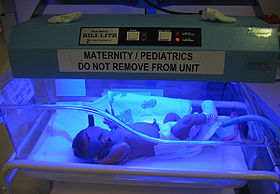Phototherapy
Phototherapy is a physical treatment option for children with neonatal jaundice . Short-wave blue light with a wavelength of around 455 nm is used. The irradiated light energy converts water-insoluble (indirect) bilirubin stored in the skin of the newborn into a water-soluble isomer , the so-called lumirubin , and can then be excreted via the bile and the kidneys .
indication
Phototherapy is used in newborns with particularly severe jaundice or jaundice that increases rapidly and early. This is to avoid a serious complication of the otherwise harmless disorder, the so-called bilirubin encephalopathy , also known as kernicterus . The limits of the bilirubin concentration in the blood at which therapy should be given are specified in guidelines of the relevant specialist society.
execution
For phototherapy, lamps with fluorescent tubes or blue LEDs , whose spectrum is as close as possible to the effective wavelength of 455 nm, are used. The lamps are placed over a warming bed or incubator . Since the more skin area is irradiated, the more effective the therapy is, the newborns are only wearing the smallest possible diaper under the light source. Since the irradiance decreases with the square of the distance from the light source, the effectiveness of the treatment can be increased if the lamp is brought closer to the newborn. Regular change of position increases efficiency.
There are also so-called luminous mats, which are placed in the bed and emit the blue light via fiber optics . The newborn baby then lies naked on this light mat, like on a sun bed.
If an excessive increase in the bilirubin concentration makes it necessary, the intensity can be increased further by irradiating with the light mat from below and the phototherapy lamp from above at the same time.
Depending on the urgency, phototherapy can be used intermittently every four to six hours or continuously.
Side effects
Although it is a seemingly harmless application of simple light, phototherapy is not free from side effects either. The irradiated energy leads to increased evaporation of water through the skin and thus to increased water and salt losses. The retina of the eyes reacts particularly sensitively to the high-energy rays of light. In order to avoid damage, the eyes of the treated children must therefore be covered with special “glasses”. The thin and sensitive skin of the newborn can also react to the treatment with inflammation. Furthermore, the heat regulation can be disturbed. In the case of glucose-6-phosphate dehydrogenase deficiency , light therapy is contraindicated (photohemolysis). Irradiation with increased levels of direct bilirubin leads to brown discoloration of the skin and internal organs ( bronze baby syndrome ). Organizationally, some clinics are not yet able to carry out phototherapy in the mother's room, so that the child may separate from the mother.
literature
- K. Jahresig , D. Jahresig, P. Meisel: Phototherapy - The treatment of neonatal icterus with visible light . Quintessenz, Munich 1993 (English parallel edition Phototherapy )
Individual evidence
- ↑ a b Hyperbilirubinemia of the Newborn - Diagnosis and Therapy , AWMF Guideline of the Society for Neonatology and Pediatric Intensive Care Medicine (in charge), Register number 024-007
- ↑ DIN 5031-10: 2013
- ↑ M. Berns: Hyperbilirubinemia in the mature newborn - limits of intervention. In: Monthly Pediatric Medicine , 2006; 154, pp. 835-843
